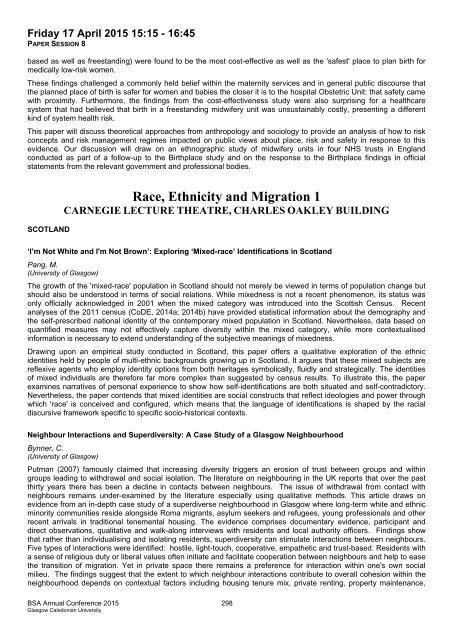Programme full
Programme full
Programme full
You also want an ePaper? Increase the reach of your titles
YUMPU automatically turns print PDFs into web optimized ePapers that Google loves.
Friday 17 April 2015 15:15 - 16:45<br />
PAPER SESSION 8<br />
based as well as freestanding) were found to be the most cost-effective as well as the 'safest' place to plan birth for<br />
medically low-risk women.<br />
These findings challenged a commonly held belief within the maternity services and in general public discourse that<br />
the planned place of birth is safer for women and babies the closer it is to the hospital Obstetric Unit: that safety came<br />
with proximity. Furthermore, the findings from the cost-effectiveness study were also surprising for a healthcare<br />
system that had believed that birth in a freestanding midwifery unit was unsustainably costly, presenting a different<br />
kind of system health risk.<br />
This paper will discuss theoretical approaches from anthropology and sociology to provide an analysis of how to risk<br />
concepts and risk management regimes impacted on public views about place, risk and safety in response to this<br />
evidence. Our discussion will draw on an ethnographic study of midwifery units in four NHS trusts in England<br />
conducted as part of a follow-up to the Birthplace study and on the response to the Birthplace findings in official<br />
statements from the relevant government and professional bodies.<br />
SCOTLAND<br />
Race, Ethnicity and Migration 1<br />
CARNEGIE LECTURE THEATRE, CHARLES OAKLEY BUILDING<br />
‘I’m Not White and I'm Not Brown’: Exploring ‘Mixed-race’ Identifications in Scotland<br />
Pang, M.<br />
(University of Glasgow)<br />
The growth of the 'mixed-race' population in Scotland should not merely be viewed in terms of population change but<br />
should also be understood in terms of social relations. While mixedness is not a recent phenomenon, its status was<br />
only officially acknowledged in 2001 when the mixed category was introduced into the Scottish Census. Recent<br />
analyses of the 2011 census (CoDE, 2014a; 2014b) have provided statistical information about the demography and<br />
the self-prescribed national identity of the contemporary mixed population in Scotland. Nevertheless, data based on<br />
quantified measures may not effectively capture diversity within the mixed category, while more contextualised<br />
information is necessary to extend understanding of the subjective meanings of mixedness.<br />
Drawing upon an empirical study conducted in Scotland, this paper offers a qualitative exploration of the ethnic<br />
identities held by people of multi-ethnic backgrounds growing up in Scotland. It argues that these mixed subjects are<br />
reflexive agents who employ identity options from both heritages symbolically, fluidly and strategically. The identities<br />
of mixed individuals are therefore far more complex than suggested by census results. To illustrate this, the paper<br />
examines narratives of personal experience to show how self-identifications are both situated and self-contradictory.<br />
Nevertheless, the paper contends that mixed identities are social constructs that reflect ideologies and power through<br />
which 'race' is conceived and configured, which means that the language of identifications is shaped by the racial<br />
discursive framework specific to specific socio-historical contexts.<br />
Neighbour Interactions and Superdiversity: A Case Study of a Glasgow Neighbourhood<br />
Bynner, C.<br />
(University of Glasgow)<br />
Putman (2007) famously claimed that increasing diversity triggers an erosion of trust between groups and within<br />
groups leading to withdrawal and social isolation. The literature on neighbouring in the UK reports that over the past<br />
thirty years there has been a decline in contacts between neighbours. The issue of withdrawal from contact with<br />
neighbours remains under-examined by the literature especially using qualitative methods. This article draws on<br />
evidence from an in-depth case study of a superdiverse neighbourhood in Glasgow where long-term white and ethnic<br />
minority communities reside alongside Roma migrants, asylum seekers and refugees, young professionals and other<br />
recent arrivals in traditional tenemental housing. The evidence comprises documentary evidence, participant and<br />
direct observations, qualitative and walk-along interviews with residents and local authority officers. Findings show<br />
that rather than individualising and isolating residents, superdiversity can stimulate interactions between neighbours.<br />
Five types of interactions were identified: hostile, light-touch, cooperative, empathetic and trust-based. Residents with<br />
a sense of religious duty or liberal values often initiate and facilitate cooperation between neighbours and help to ease<br />
the transition of migration. Yet in private space there remains a preference for interaction within one's own social<br />
milieu. The findings suggest that the extent to which neighbour interactions contribute to overall cohesion within the<br />
neighbourhood depends on contextual factors including housing tenure mix, private renting, property maintenance,<br />
BSA Annual Conference 2015 298<br />
Glasgow Caledonian University


